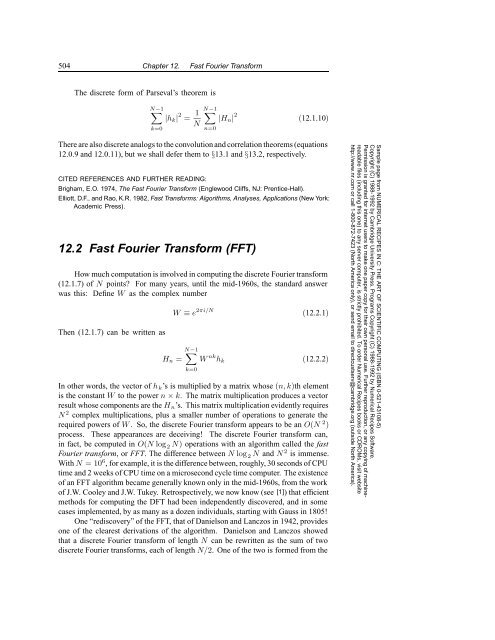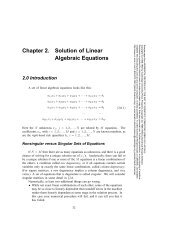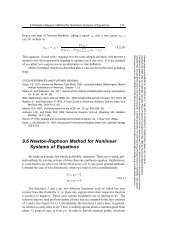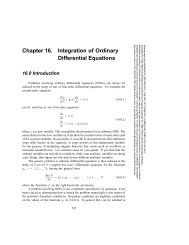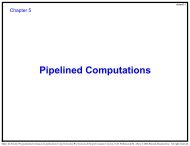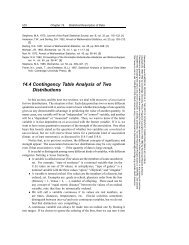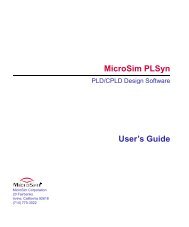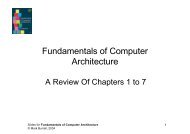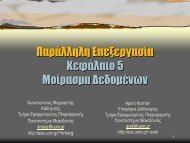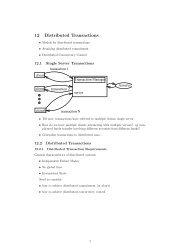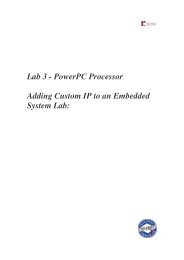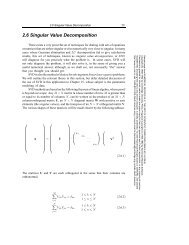12.2 Fast Fourier Transform (FFT)
12.2 Fast Fourier Transform (FFT)
12.2 Fast Fourier Transform (FFT)
- No tags were found...
You also want an ePaper? Increase the reach of your titles
YUMPU automatically turns print PDFs into web optimized ePapers that Google loves.
<strong>12.2</strong> <strong>Fast</strong> <strong>Fourier</strong> <strong>Transform</strong> (<strong>FFT</strong>) 505even-numbered points of the original N, the other from the odd-numbered points.The proof is simply this:F k ===N−1∑j=0N/2−1∑j=0N/2−1∑j=0e 2πijk/N f j= F e k + W k F o kN/2−1∑e 2πik(2j)/N f 2j +j=0N/2−1∑e 2πikj/(N/2) f 2j + W ke 2πik(2j+1)/N f 2j+1j=0e 2πikj/(N/2) f 2j+1(<strong>12.2</strong>.3)In the last line, W is the same complex constant as in (<strong>12.2</strong>.1), F k e denotes the kthcomponent of the <strong>Fourier</strong> transform of length N/2 formed from the even componentsof the original f j ’s, while Fk o is the corresponding transform of length N/2 formedfrom the odd components. Notice also that k in the last line of (<strong>12.2</strong>.3) varies from0 to N, not just to N/2. Nevertheless, the transforms Fk e and F k o are periodic in kwith length N/2. So each is repeated through two cycles to obtain F k .The wonderful thing about the Danielson-Lanczos Lemma is that it can be usedrecursively. Having reduced the problem of computing F k to that of computingFk e and F k o, we can do the same reduction of F k e to the problem of computingthe transform of its N/4 even-numbered input data and N/4 odd-numbered data.In other words, we can define Fkee and Fkeo to be the discrete <strong>Fourier</strong> transformsof the points which are respectively even-even and even-odd on the successivesubdivisions of the data.Although there are ways of treating other cases, by far the easiest case is theone in which the original N is an integer power of 2. In fact, we categoricallyrecommend that you only use <strong>FFT</strong>s with N a power of two. If the length of your dataset is not a power of two, pad it with zeros up to the next power of two. (We will givemore sophisticated suggestions in subsequent sections below.) With this restrictionon N, it is evident that we can continue applying the Danielson-Lanczos Lemmauntil we have subdivided the data all the way down to transforms of length 1. Whatis the <strong>Fourier</strong> transform of length one? It is just the identity operation that copies itsone input number into its one output slot! In other words, for every pattern of log 2 Ne’s and o’s, there is a one-point transform that is just one of the input numbers f nF eoeeoeo···oeek = f n for some n (<strong>12.2</strong>.4)(Of course this one-point transform actually does not depend on k, since it is periodicin k with period 1.)The next trick is to figure out which value of n corresponds to which pattern ofe’s and o’s in equation (<strong>12.2</strong>.4). The answer is: Reverse the pattern of e’s and o’s,then let e =0and o =1, and you will have, in binary the value of n. Do you seewhy it works? It is because the successive subdivisions of the data into even and oddare tests of successive low-order (least significant) bits of n. This idea of bit reversalcan be exploited in a very clever way which, along with the Danielson-LanczosSample page from NUMERICAL RECIPES IN C: THE ART OF SCIENTIFIC COMPUTING (ISBN 0-521-43108-5)Copyright (C) 1988-1992 by Cambridge University Press. Programs Copyright (C) 1988-1992 by Numerical Recipes Software.Permission is granted for internet users to make one paper copy for their own personal use. Further reproduction, or any copying of machinereadablefiles (including this one) to any server computer, is strictly prohibited. To order Numerical Recipes books or CDROMs, visit websitehttp://www.nr.com or call 1-800-872-7423 (North America only), or send email to directcustserv@cambridge.org (outside North America).
506 Chapter 12. <strong>Fast</strong> <strong>Fourier</strong> <strong>Transform</strong>000001010000001010000001010011100101110111(a)(b)Figure <strong>12.2</strong>.1. Reordering an array (here of length 8) by bit reversal, (a) between two arrays, versus (b)in place. Bit reversal reordering is a necessary part of the fast <strong>Fourier</strong> transform (<strong>FFT</strong>) algorithm.Lemma, makes <strong>FFT</strong>s practical: Suppose we take the original vector of data f jand rearrange it into bit-reversed order (see Figure <strong>12.2</strong>.1), so that the individualnumbers are in the order not of j, but of the number obtained by bit-reversing j.Then the bookkeeping on the recursive application of the Danielson-Lanczos Lemmabecomes extraordinarily simple. The points as given are the one-point transforms.We combine adjacent pairs to get two-point transforms, then combine adjacent pairsof pairs to get 4-point transforms, and so on, until the first and second halves ofthe whole data set are combined into the final transform. Each combination takesof order N operations, and there are evidently log 2 N combinations, so the wholealgorithm is of order N log 2 N (assuming, as is the case, that the process of sortinginto bit-reversed order is no greater in order than N log 2 N).This, then, is the structure of an <strong>FFT</strong> algorithm: It has two sections. The firstsection sorts the data into bit-reversed order. Luckily this takes no additional storage,since it involves only swapping pairs of elements. (If k 1 is the bit reverse of k 2 , thenk 2 is the bit reverse of k 1 .) The second section has an outer loop that is executedlog 2 N times and calculates, in turn, transforms of length 2, 4, 8,...,N. For eachstage of this process, two nested inner loops range over the subtransforms alreadycomputed and the elements of each transform, implementing the Danielson-LanczosLemma. The operation is made more efficient by restricting external calls fortrigonometric sines and cosines to the outer loop, where they are made only log 2 Ntimes. Computation of the sines and cosines of multiple angles is through simplerecurrence relations in the inner loops (cf. 5.5.6).The <strong>FFT</strong> routine given below is based on one originally written by N. M.Brenner. The input quantities are the number of complex data points (nn), the dataarray (data[1..2*nn]), and isign, which should be set to either ±1 and is the signof i in the exponential of equation (12.1.7). When isign is set to −1, the routinethus calculates the inverse transform (12.1.9) — except that it does not multiply bythe normalizing factor 1/N that appears in that equation. You can do that yourself.Notice that the argument nn is the number of complex data points. The actual011100101110111011100101110111Sample page from NUMERICAL RECIPES IN C: THE ART OF SCIENTIFIC COMPUTING (ISBN 0-521-43108-5)Copyright (C) 1988-1992 by Cambridge University Press. Programs Copyright (C) 1988-1992 by Numerical Recipes Software.Permission is granted for internet users to make one paper copy for their own personal use. Further reproduction, or any copying of machinereadablefiles (including this one) to any server computer, is strictly prohibited. To order Numerical Recipes books or CDROMs, visit websitehttp://www.nr.com or call 1-800-872-7423 (North America only), or send email to directcustserv@cambridge.org (outside North America).
<strong>12.2</strong> <strong>Fast</strong> <strong>Fourier</strong> <strong>Transform</strong> (<strong>FFT</strong>) 507length of the real array (data[1..2*nn]) is 2 times nn, with each complex valueoccupying two consecutive locations. In other words, data[1] is the real part off 0 , data[2] is the imaginary part of f 0 , and so on up to data[2*nn-1], whichis the real part of f N−1 , and data[2*nn], which is the imaginary part of f N−1 .The <strong>FFT</strong> routine gives back the F n ’s packed in exactly the same fashion, as nncomplex numbers.The real and imaginary parts of the zero frequency component F 0 are in data[1]and data[2]; the smallest nonzero positive frequency has real and imaginary parts indata[3] and data[4]; the smallest (in magnitude) nonzero negative frequency hasreal and imaginary parts in data[2*nn-1] and data[2*nn]. Positive frequenciesincreasing in magnitude are stored in the real-imaginary pairs data[5], data[6]up to data[nn-1], data[nn]. Negative frequencies of increasing magnitude arestored in data[2*nn-3], data[2*nn-2] down to data[nn+3], data[nn+4].Finally, the pair data[nn+1], data[nn+2] contain the real and imaginary parts ofthe one aliased point that contains the most positive and the most negative frequency.You should try to develop a familiarity with this storage arrangement of complexspectra, also shown in Figure <strong>12.2</strong>.2, since it is the practical standard.This is a good place to remind you that you can also use a routine like four1without modification even if your input data array is zero-offset, that is has the rangedata[0..2*nn-1]. In this case, simply decrement the pointer to data by one whenfour1 is invoked, e.g., four1(data-1,1024,1);. The real part of f 0 will now bereturned in data[0], the imaginary part in data[1], and so on. See §1.2.#include #define SWAP(a,b) tempr=(a);(a)=(b);(b)=temprvoid four1(float data[], unsigned long nn, int isign)Replaces data[1..2*nn] by its discrete <strong>Fourier</strong> transform, if isign is input as 1; or replacesdata[1..2*nn] by nn times its inverse discrete <strong>Fourier</strong> transform, if isign is input as −1.data is a complex array of length nn or, equivalently, a real array of length 2*nn. nn MUSTbe an integer power of 2 (this is not checked for!).{unsigned long n,mmax,m,j,istep,i;double wtemp,wr,wpr,wpi,wi,theta;Double precision for the trigonometricfloat tempr,tempi;recurrences.n=nn = 2 && j > m) {j -= m;m >>= 1;}j += m;}Here begins the Danielson-Lanczos section of the routine.mmax=2;while (n > mmax) {istep=mmax
508 Chapter 12. <strong>Fast</strong> <strong>Fourier</strong> <strong>Transform</strong>12realimagt = 012realimagf = 034realimagt = ∆34realimagf =1N∆real array of length 2N(a)2N − 32N − 22N − 12Nrealimagrealimagt = (N − 2)∆t = (N − 1)∆real array of length 2N(b)N − 1NN + 1N + 2N + 3N + 42N − 12Nrealimagrealimagrealimagrealimagf =f = ±f = −f = −N/2 − 1N∆12∆1N∆(combination)N/2 − 1N∆Figure <strong>12.2</strong>.2. Input and output arrays for <strong>FFT</strong>. (a) The input array contains N (a power of 2)complex time samples in a real array of length 2N, with real and imaginary parts alternating. (b) Theoutput array contains the complex <strong>Fourier</strong> spectrum at N values of frequency. Real and imaginary partsagain alternate. The array starts with zero frequency, works up to the most positive frequency (whichis ambiguous with the most negative frequency). Negative frequencies follow, from the second-mostnegative up to the frequency just below zero.}}wpi=sin(theta);wr=1.0;wi=0.0;for (m=1;m
<strong>12.2</strong> <strong>Fast</strong> <strong>Fourier</strong> <strong>Transform</strong> (<strong>FFT</strong>) 509Other <strong>FFT</strong> AlgorithmsWe should mention that there are a number of variants on the basic <strong>FFT</strong> algorithmgiven above. As we have seen, that algorithm first rearranges the input elementsinto bit-reverse order, then builds up the output transform in log 2 N iterations. Inthe literature, this sequence is called a decimation-in-time or Cooley-Tukey <strong>FFT</strong>algorithm. It is also possible to derive <strong>FFT</strong> algorithms that first go through a set oflog 2 N iterations on the input data, and rearrange the output values into bit-reverseorder. These are called decimation-in-frequencyor Sande-Tukey <strong>FFT</strong> algorithms. Forsome applications, such as convolution (§13.1), one takes a data set into the <strong>Fourier</strong>domain and then, after some manipulation, back out again. In these cases it is possibleto avoid all bit reversing. You use a decimation-in-frequency algorithm (without itsbit reversing) to get into the “scrambled” <strong>Fourier</strong> domain, do your operations there,and then use an inverse algorithm (without its bit reversing) to get back to the timedomain. While elegant in principle, this procedure does not in practice save muchcomputation time, since the bit reversals represent only a small fraction of an <strong>FFT</strong>’soperations count, and since most useful operations in the frequency domain requirea knowledge of which points correspond to which frequencies.Another class of <strong>FFT</strong>s subdivides the initial data set of length N not all theway down to the trivial transform of length 1, but rather only down to some othersmall power of 2, for example N =4, base-4 <strong>FFT</strong>s, orN =8, base-8 <strong>FFT</strong>s. Thesesmall transforms are then done by small sections of highly optimized coding whichtake advantage of special symmetries of that particular small N. For example, forN =4, the trigonometric sines and cosines that enter are all ±1 or 0, so manymultiplications are eliminated, leaving largely additions and subtractions. Thesecan be faster than simpler <strong>FFT</strong>s by some significant, but not overwhelming, factor,e.g., 20 or 30 percent.There are also <strong>FFT</strong> algorithms for data sets of length N not a power of two. Theywork by using relations analogous to the Danielson-Lanczos Lemma to subdividethe initial problem into successively smaller problems, not by factors of 2, but bywhatever small prime factors happen to divide N. The larger that the largest primefactor of N is, the worse this method works. If N is prime, then no subdivisionis possible, and the user (whether he knows it or not) is taking a slow <strong>Fourier</strong>transform, of order N 2 instead of order N log 2 N. Our advice is to stay clearof such <strong>FFT</strong> implementations, with perhaps one class of exceptions, the Winograd<strong>Fourier</strong> transform algorithms. Winograd algorithms are in some ways analogous tothe base-4 and base-8 <strong>FFT</strong>s. Winograd has derived highly optimized codings fortaking small-N discrete <strong>Fourier</strong> transforms, e.g., for N =2, 3, 4, 5, 7, 8, 11, 13, 16.The algorithms also use a new and clever way of combining the subfactors. Themethod involves a reordering of the data both before the hierarchical processing andafter it, but it allows a significant reduction in the number of multiplications in thealgorithm. For some especially favorable values of N, the Winograd algorithms canbe significantly (e.g., up to a factor of 2) faster than the simpler <strong>FFT</strong> algorithmsof the nearest integer power of 2. This advantage in speed, however, must beweighed against the considerably more complicated data indexing involved in thesetransforms, and the fact that the Winograd transform cannot be done “in place.”Finally, an interesting class of transforms for doing convolutions quickly arenumber theoretic transforms. These schemes replace floating-point arithmetic withSample page from NUMERICAL RECIPES IN C: THE ART OF SCIENTIFIC COMPUTING (ISBN 0-521-43108-5)Copyright (C) 1988-1992 by Cambridge University Press. Programs Copyright (C) 1988-1992 by Numerical Recipes Software.Permission is granted for internet users to make one paper copy for their own personal use. Further reproduction, or any copying of machinereadablefiles (including this one) to any server computer, is strictly prohibited. To order Numerical Recipes books or CDROMs, visit websitehttp://www.nr.com or call 1-800-872-7423 (North America only), or send email to directcustserv@cambridge.org (outside North America).
510 Chapter 12. <strong>Fast</strong> <strong>Fourier</strong> <strong>Transform</strong>integer arithmetic modulo some large prime N+1, and the Nth root of 1 by themodulo arithmetic equivalent. Strictly speaking, these are not <strong>Fourier</strong> transformsat all, but the properties are quite similar and computational speed can be farsuperior. On the other hand, their use is somewhat restricted to quantities likecorrelations and convolutions since the transform itself is not easily interpretableas a “frequency” spectrum.CITED REFERENCES AND FURTHER READING:Nussbaumer, H.J. 1982, <strong>Fast</strong> <strong>Fourier</strong> <strong>Transform</strong> and Convolution Algorithms (New York: Springer-Verlag).Elliott, D.F., and Rao, K.R. 1982, <strong>Fast</strong> <strong>Transform</strong>s: Algorithms, Analyses, Applications (New York:Academic Press).Brigham, E.O. 1974, The <strong>Fast</strong> <strong>Fourier</strong> <strong>Transform</strong> (Englewood Cliffs, NJ: Prentice-Hall). [1]Bloomfield, P. 1976, <strong>Fourier</strong> Analysis of Time Series – An Introduction (New York: Wiley).Van Loan, C. 1992, Computational Frameworks for the <strong>Fast</strong> <strong>Fourier</strong> <strong>Transform</strong> (Philadelphia:S.I.A.M.).Beauchamp, K.G. 1984, Applications of Walsh Functions and Related Functions (New York:Academic Press) [non-<strong>Fourier</strong> transforms].Heideman, M.T., Johnson, D.H., and Burris, C.S. 1984, IEEE ASSP Magazine, pp. 14–21 (October).12.3 <strong>FFT</strong> of Real Functions, Sine and Cosine<strong>Transform</strong>sIt happens frequently that the data whose <strong>FFT</strong> is desired consist of real-valuedsamples f j , j =0...N − 1. To use four1, we put these into a complex arraywith all imaginary parts set to zero. The resulting transform F n ,n=0...N − 1satisfies F N−n *=F n . Since this complex-valued array has real values for F 0and F N/2 , and (N/2) − 1 other independent values F 1 ...F N/2−1 , it has the same2(N/2 − 1) + 2 = N “degrees of freedom” as the original, real data set. However,the use of the full complex <strong>FFT</strong> algorithm for real data is inefficient, both in executiontime and in storage required. You would think that there is a better way.There are two better ways. The first is “mass production”: Pack two separatereal functions into the input array in such a way that their individual transforms canbe separated from the result. This is implemented in the program twofft below.This may remind you of a one-cent sale, at which you are coerced to purchasetwo of an item when you only need one. However, remember that for correlationsand convolutions the <strong>Fourier</strong> transforms of two functions are involved, and this is ahandy way to do them both at once. The second method is to pack the real inputarray cleverly, without extra zeros, into a complex array of half its length. One thenperforms a complex <strong>FFT</strong> on this shorter length; the trick is then to get the requiredanswer out of the result. This is done in the program realft below.Sample page from NUMERICAL RECIPES IN C: THE ART OF SCIENTIFIC COMPUTING (ISBN 0-521-43108-5)Copyright (C) 1988-1992 by Cambridge University Press. Programs Copyright (C) 1988-1992 by Numerical Recipes Software.Permission is granted for internet users to make one paper copy for their own personal use. Further reproduction, or any copying of machinereadablefiles (including this one) to any server computer, is strictly prohibited. To order Numerical Recipes books or CDROMs, visit websitehttp://www.nr.com or call 1-800-872-7423 (North America only), or send email to directcustserv@cambridge.org (outside North America).


